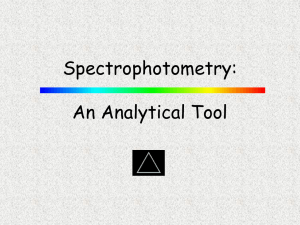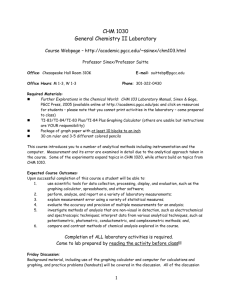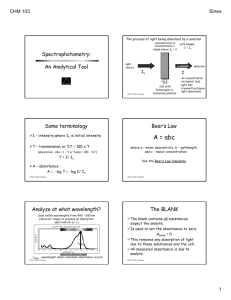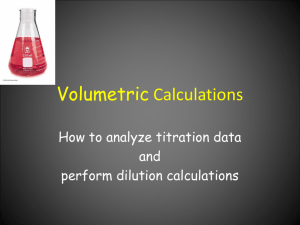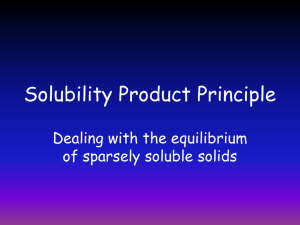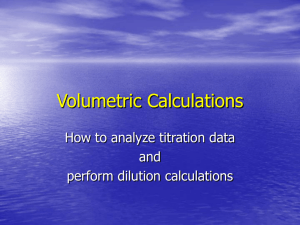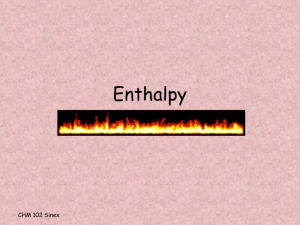Spectroscopy
advertisement
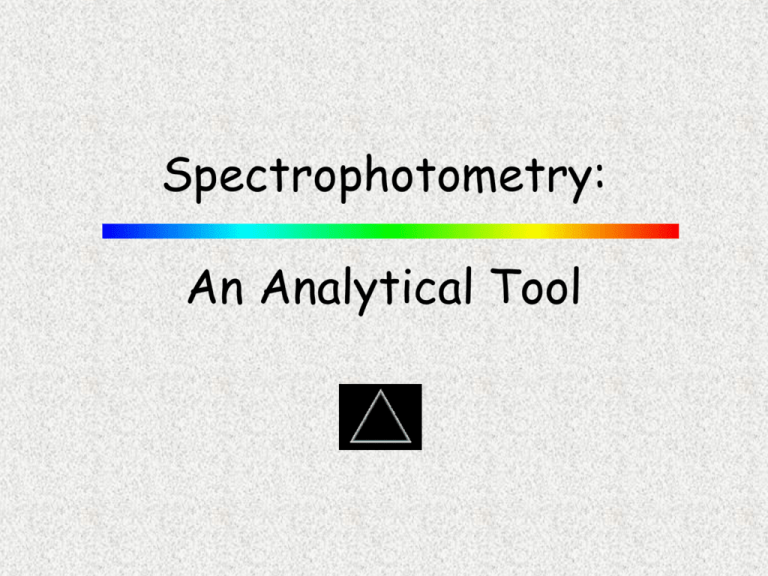
Spectrophotometry: An Analytical Tool The process of light being absorbed by a solution concentration 2 concentration 1 blank where Io = I light source with sample I < Io detector Io I b PGCC CHM 103 Sinex/Gage Cell with Pathlength, b, containing solution As concentration increases, less light is transmitted (more light absorbed). Some terminology I – intensity where Io is initial intensity of light entering a solution and I is the intensity of light exiting a solution T – transmission (no units, ratio) T = I/ Io %T = 100 x T (absorption: Abs = 1 – T or %Abs = 100 - %T) A – absorbance (no units) A = - log T = -log I/ Io PGCC CHM 103 Sinex/Gage Remembering the “More Lights, Color, Absorption” lab activity, what factors affect the amount of light that is absorbed by a solution in a spectrometer? PGCC CHM 103 Sinex/Gage Beer’s Law A = abc where a = molar absorptivity (actually the symbol ε is the correct symbol for this but a is easier to remember) b = pathlength c = molar concentration See the Beer’s Law Simulator PGCC CHM 103 Sinex/Gage Molar absorptivity • Depends on the electronic structure of the substance being analyzed (analyte) • Varies with the wavelength of light because a compound absorbs different amounts at different wavelengths • Units = L mol-1 cm-1 (a = A/bc = 1/(mol/L x cm)) PGCC CHM 103 Sinex/Gage Analyze at what wavelength? Scan visible wavelengths from 400 – 650 nm (detector range) to produce an absorption spectrum (A vs. l) Crystal Violet Absorption Spectrum 1.4 Absorbance 1.2 1 0.8 0.6 lmax 0.4 0.2 0 200 250 300 350 400 450 500 wavelength, nm 550 600 650 phototube detector range 700 750 lmax - wavelength where maximum absorbance occurs PGCC CHM 103 Sinex/Gage The BLANK The blank contains all substances except the analyte. Is used to set the absorbance to zero: Ablank = 0 This removes any absorption of light due to these substances and the cell. All measured absorbance is due to analyte. PGCC CHM 103 Sinex/Gage The components of a Spec-20D Light source - white light of constant intensity slits filter occluder Grating Phototube detects light & measures intensity slits Sample When blank is the sample Io is determined PGCC CHM 103 otherwise I is measured Sinex/Gage Separates white light into various colors Rotating the grating changes the wavelength going through the sample IR What does the absorbed light (electromagnetic radiation) do to the molecule? 700 nm visible Energy increasing UV 400 nm high energy UV – ionizes electrons low energy UV and visible – promotes electrons to higher energy orbitals (absorption of visible light leads to a colored solution) IR – causes molecules to vibrate (more later) PGCC CHM 103 Sinex/Gage UV/visible light absorption Valence electrons In organic molecules, electronic transitions to higher energy molecular orbitals – double bonds: p p* In transition metals, hydrated ions such as Cu2+ have splitting of d orbital energies and electronic transitions – weak absorption In complexed transition metals, charge transfer of electrons from metal to ligand as Cu(NH3)42+ – strong absorption PGCC CHM 103 Sinex/Gage Uses of visible spectrophotometry Analysis of unknowns using Beer’s Law calibration curve (Been there, done that!) Absorbance vs. time graphs for kinetics Single-point calibration for an equilibrium constant determination Spectrophotometric titrations – a way to follow a reaction if at least one substance is colored – sudden or sharp change in absorbance at equivalence point, a piece-wise function PGCC CHM 103 Sinex/Gage Standard Curves A b s o r b a n c e regression equation 0.01 0.02 0.03 0.04 0.05 Concentration (mol/L or M) PGCC CHM 103 Sinex/Gage 0.06 0.07 If you know the absorbance of an unknown you can determine the concentration. Kinetics of Crystal Violet Reaction CV+ + OH- CV-OH purple colorless colorless Follow concentration of crystal violet over time as it reacts by measuring its absorbance. How will absorbance change with time? For a absorbance vs. time plot, how will you determine the rate of the reaction? PGCC CHM 103 Sinex/Gage Chime structures CV+ + OH CV-OH purple colorless colorless This is tracking reaction progress over time. absorbance Since the absorbance is related to concentration, rate or DA/Dtime is the slope of a regression line. Short run times to get initial rates. time PGCC CHM 103 Sinex/Gage STELLA model Single-point calibration • Standard with measured absorbance Astd = abcstd • Unknown with measured absorbance Aunk = abcunk Ratio the two equations Aunk/ Astd = abcunk /abcstd Aunk/ Astd = cunk /cstd • Solve for cunk PGCC CHM 103 Sinex/Gage Equilibrium Constant Determination Fe+3 colorless + SCN- = Fe(SCN)++ colorless orange K = (Fe(SCN)++)/(Fe+3)(SCN-) Using the reactants, shift reaction based on Le Chatelier’s principle. Fe(SCN)++ + SCN- = Fe(SCN)2+ We start with a high concentration of Fe+3 and lower its value by dilution. PGCC CHM 103 Sinex/Gage Interactive Excel spreadsheet When calibration curves go bad! • The linear Beer’s Law relationship starts to show curvature at high concentrations Absorbance 1 Calibration Curve 0.8 Non-linear 0.6 linear curved Linear (linear) 0.4 0.2 0 0 0.2 0.4 0.6 concentration 0.8 1 • Single-point calibration assumes a linear calibration curve PGCC CHM 103 Sinex/Gage Spectrophotometric titration • Let’s consider the analysis of hydrogen peroxide with potassium permanganate in an acidic solution. • The potassium permanganate or MnO4is the only colored substance in the reaction. (It can serve as its own indicator.) • How would the absorbance change as titrant was added? PGCC CHM 103 Sinex/Gage absorbance 5H2O2 + 2MnO4- + 6H+ 5O2 (g) + purple 2Mn+2 + 8H2O Notice you do not need to have a data point at the equivalence point. Equivalence point located by extrapolation of the two lines. Equivalence point MnO4- reacting, color disappears xs MnO4accumulates Volume of titrant (mL KMnO4) PGCC CHM 103 Sinex/Gage
